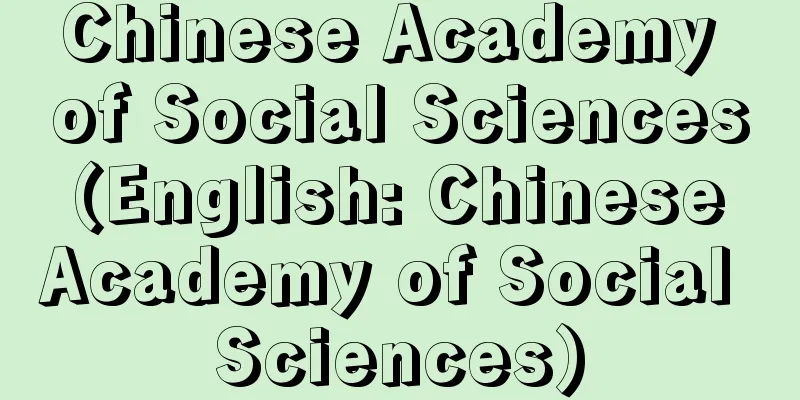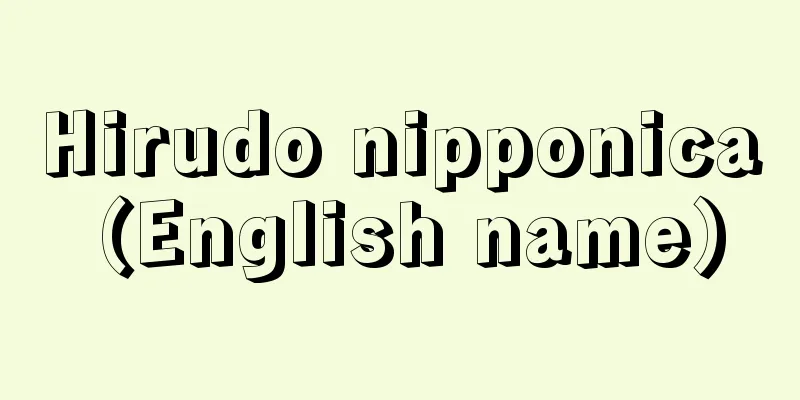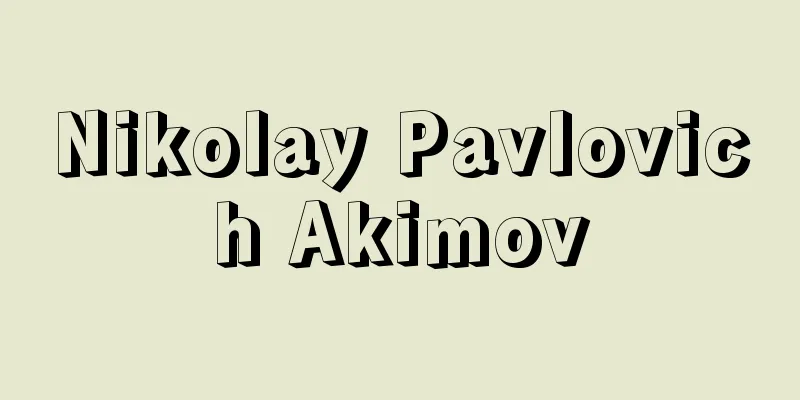Historical research - Kōshōgaku

|
The name of the academic field that was central to Confucianism during the Qing Dynasty. Evidence-based research is the process of clarifying facts by providing objective evidence, and therefore has existed in all ages as a part of academic research, and is not limited to the Qing Dynasty. However, at that time, a field of study that held up the slogan "Seeking truth from facts" and boasted of being the "study of evidence" was flourishing, and in fact many works that fit this description were published, so this term became a specific term for the study of Qing Confucianism. Incidentally, it is common to refer to the characteristics of Confucianism in China throughout the ages as "Han and Tang Exegesis," "Song and Ming Neo-Confucianism," and "Qing Dynasty Evidence-Based Studies," but this seems to have originated from Ota Kinjo in the mid-Edo period (Preface to "Dan'ai Nine Classics"). At the same time, the term Qing studies also began to be referred to as evidence-based studies, and it is thought that this term became established when Liang Qichao (Preface to "Outline of Academic Studies in the Qing Dynasty") used it in the early Republic of China. [Haruki Kusuyama] Contents of historical researchAs its proponents call it, the study of texts refers to the rejection of the Song and Ming dynasties' Neo-Confucianism as empty and the return to the study of exegesis (particularly the study of classical Chinese texts in the Later Han Dynasty as a typical example). However, this is not a simple restoration of the past; the point is to approach the true meaning of the ancient sages through the classics, and to do so, it is necessary to base it on the classics of the Han dynasty, which were closer to the time of the ancient sages and still retain their true meaning. Therefore, it was considered essential for the study of texts to be familiar with the elementary school (character studies and phonology) as a means of accurately grasping the meaning of ancient languages. On the other hand, the study of ancient languages also required the reference of the writings of various scholars, which were also ancient documents, but because they had been left unstudyed for many years without anyone studying them, there were noticeable errors in the characters. Therefore, the task of collating the various texts to create accurate texts was undertaken, and the study of text collation developed from this point on. Furthermore, interest also grew in bronze and stone inscriptions with characters that date back to the same period as the scriptures or an earlier period, and the study of these became popular as a form of epigraphy. On the other hand, in order to thoroughly read and understand the scriptures, one must accurately know everything that appears in them, from the names of people, places, and official titles to the celestial phenomena of the sun, moon, and stars, plants and animals, and implements, and various other fields of study such as history, geography, the imperial system, and astronomy arose as auxiliary studies for this purpose. The term "textual study" refers to such a broad range of academic fields, and although the focus is of course on the study of scriptures, the subject matter is not necessarily limited to scriptures. For this reason, the original purpose of approaching the true intentions of the ancient sages is sometimes forgotten, and there is a tendency for textual study to become an end in itself. However, the results are precise enough to withstand contemporary academic criticism. [Haruki Kusuyama] Various schools and trends in textual researchThe study of historical evidence began when Gu Yanwu, who was at the end of the Ming and beginning of the Qing dynasties, wrote "Nichinichiroku" (Records of the Rice Cult), which set the prototype of historical evidence, and his disciple Yan Ruoying wrote "Commentary on the Ancient Texts and the Books of Classics" (Commentary on the Ancient Texts and the Books of Classics), which pointed out that traditional scriptures actually contained forgeries created in the 4th century. However, its heyday was during the Qianlong and Jiaqing periods from the late 18th century to the early 19th century. There were two school of textual criticism in this period: the Wu school (Suzhou school) produced Huidong (I Ching-An), Qian Dayuxin (The New Records of the Shijiazhai Yang), and Wang Mingsheng (The Seventeen Histories of Shangzhi), while the Wan school (Anhui school) produced Dai Zhen (Commentary on the Meaning of Mencius), Duan Yucai (Annotated Commentary on Shuowen Zi), Wang Niansun (Reading Journal, Guangya Commentary), and Wang Yinzhi (Commentary on the Classics of Classics). In addition, Wan Sitong and Quan Zu Wang, who were from the school of Huang Zongxi ('Antiquarian Confucianism of the Ming') in the late Ming and early Qing dynasties, achieved great success mainly in the field of history, while Jiang Fan ('Records of the Chinese Scholars of the State') and Ruan Yuan ('Journeys of the Classic of the Imperial Qing') played the role of compiling the scholarship of their time and passing it on to future generations. After the Qianlong and Jiaqing periods, the interest of Qing Confucians shifted from the Classical Classics of the Later Han Dynasty to the Modern Classics of the Western Han Dynasty. However, Modern Classics was originally more political than exegesis, and as it happened to be during the turbulent period at the end of the Qing Dynasty, the mainstream of its study was inclined to seek the theoretical basis of the reform movement in it. This was the Gongyang School of the Qing Dynasty. However, the tradition of textual research remained in the scholarship of Sun Yirang, Yu Yue, Wang Xianqian and others, and was carried on by the scientific study of the classics that arose after the Republic of China. [Haruki Kusuyama] "Classics," "History and Literature," by Naito Konan (included in "General Treatise on the History of the Qing Dynasty," 1944, Kobundo; included in "Complete Works of Naito Konan, Volume 8," 1969, Chikuma Shobo)" ▽ "An Introduction to Academic Studies in the Qing Dynasty," by Liang Qichao, translated by Ono Kazuko (Heibonsha, Toyo Bunko)" Source: Shogakukan Encyclopedia Nipponica About Encyclopedia Nipponica Information | Legend |
|
清朝(しんちょう)一代の儒学において中心をなしていた学問の称。考証とは客観的な証拠をあげて事実を明らかにすること、したがってそれは学問研究の一過程としていつの時代にもあり、清代にのみ限るものではない。ただその当時に「実事求是(じつじきゅうぜ)」(事実によって真理を明らかにする)をスローガンとして掲げ、自らを「考拠の学」と誇称する学問が盛行し、事実それにふさわしい著作の続出したことから、清儒の学を特定する称呼となったのである。ちなみに、歴代中国における儒学の特色をとらえて、「漢唐訓詁(くんこ)学」「宋明(そうみん)性理学」「清朝考証学」と称することが一般であるが、これは江戸時代中期の太田錦城(きんじょう)(『九経談』序)に発するものであるらしく、同時に清学を考証学とよぶこともこれに始まり、その後、中華民国初期の梁啓超(りょうけいちょう)(『清代学術概論』序)がこの語を使用したことによって定着したものと考えられる。 [楠山春樹] 考証学の内容考証学は、推進者自らが漢学と称しているように、宋明の性理学を空疎として退け、訓詁学(とくにその典型としての後漢(ごかん)の古文経学(こぶんけいがく))に復(かえ)るべきことをいう。しかしそれは単なる復古ではなく、要は経書を通して古聖賢の真意に迫ろうとするにあり、それには、古聖賢の世に近く、なおその真意を残存する漢代の経学を基盤とすべきである、というのである。そこで考証学は、まず古代言語のもつ意味を的確に把握する手段として、小学(文字(もんじ)学・音韻(おんいん)学)に通ずることが必須(ひっす)とされた。一方古代言語研究には、同じく古代の文献である諸子の書をも参考とすることが必要とされたが、それらは多年学習する人もなく放置されてきたため、文字の誤りが目だった。そこで諸本を校合して正確なテキストをつくる作業が行われ、ここに校勘の学が発達する。さらに経書と同時期もしくは先行する時期の文字を刻んだ金文石文にも関心が寄せられ、これを研究する金石学が盛行する。一方経書を徹底的に読解するためには、そこにみえる人名、地名、官職名から日月星辰(せいしん)の天体現象、動植物、器物に至るまで、それを正確に知らねばならず、そのための補助学として歴史、地理、典章制度、天文などの諸学が興起する。 考証学とは、以上のような広範な学問を総称するものであって、もちろん中心は経書研究にあるが、その対象はかならずしも経書にのみ限るものではない。それだけに古聖賢の真意に迫るという本来の趣旨がときに忘却され、考証それ自体が目的化したきらいもなくはないようであるが、しかしその成果は、現今の学的批判に堪えうる精密さを備えている。 [楠山春樹] 考証学の諸派と流れ考証学は、明末清初の顧炎武(こえんぶ)が『日知録(にっちろく)』を著して考証の祖型を示し、門人閻若璩(えんじゃくきょ)が『古文尚書疏証(こぶんしょうしょそしょう)』を著して、伝統的な経書のなかに、実は4世紀につくられた偽書の混じっている事実を指摘したことに端を発する。しかしその最盛期は18世紀後半から19世紀前半にかけての乾隆(けんりゅう)・嘉慶(かけい)年間である。この時期の考証学には2系統があって、すなわち呉派(蘇州(そしゅう)学派)には恵棟(けいとう)(『易漢学』)、銭大昕(せんたいきん)(『十駕斎(じゅうがさい)養新録』)、王鳴盛(めいせい)(『十七史商榷(しょうかく)』)らがあり、皖(かん)派(安徽(あんき)学派)には戴震(たいしん)(『孟子(もうし)字義疏証(そしょう)』)、段玉裁(だんぎょくさい)(『説文解字注』)、王念孫(おうねんそん)(『読書雑志』『広雅疏証』)、王引之(おういんし)(『経伝釈詞』)らが輩出した。なお明末清初の黄宗羲(こうそうぎ)(『明儒学案』)の門流から出た万斯同(ばんしどう)、全祖望(ぜんそぼう)は史学を中心とする成果を示し、江藩(こうはん)(『国朝漢学師承記』)、阮元(げんげん)(『皇清経解』)は、当時の学問を集成して後世に伝える役割を果たしている。 乾隆・嘉慶を過ぎると清儒の関心は後漢の古文経学から、さかのぼって前漢の今文(きんぶん)経学に移っていく。しかし今文経学はもともと訓詁学というよりも政治的色彩が濃厚であり、おりしも清末の動乱期に際会したこともあって、その主流は改革運動の理論的根拠をこれに求めることに傾いていった。清朝公羊(くよう)学がそれである。しかし考証学の伝統はなお孫詒譲(そんいじょう)、兪樾(ゆえつ)、王先謙(おうせんけん)らの学問に残り、中華民国以後におこる古典の科学的研究に引き継がれていった。 [楠山春樹] 『内藤湖南著「経学」「史学及び文学」(『清朝史通論』所収・1944・弘文堂/『内藤湖南全集 第8巻』所収・1969・筑摩書房)』▽『梁啓超著、小野和子訳『清代学術概論』(平凡社・東洋文庫)』 出典 小学館 日本大百科全書(ニッポニカ)日本大百科全書(ニッポニカ)について 情報 | 凡例 |
>>: Statement of intent - Kojougaki
Recommend
Nagi
An evergreen tall tree of the Podocarpaceae family...
Miyabe Nagahiro
? - 1634 (Kan'ei 11) A military commander in t...
Character - keishitsu (English spelling)
This refers to the physical shape and characteris...
Brick rock - Hidden rock
…In addition to the diameter of the pebble, the r...
cuvette
...The dye used is indocyanine green, which is no...
Rock slide - Rock slide
...Some contain a large amount of water, while ot...
Mount Inokawa - Mount Inokawa
...The island is divided into three towns in Oshi...
Citrus leafhopper - Citrus leafhopper
…The Japanese staghorn leafhopper attacks grape l...
La jeune Parque (English spelling)
…He also wrote “Introduction to the Method of Leo...
Benzonitrile
A colorless liquid with a benzaldehyde-like odor. ...
fart
… [Takehiko Higashi] [Cultural History] In the Wa...
Lagash (English spelling)
A city in Sumer in southern Mesopotamia. The ruin...
Nagamori Oizumi - Nagamori Oizumi
...A descendant of Muto Yorihira, a bureaucrat fr...
LCAO approximation - LCAO approximation
...Therefore, the hydrogen molecule H2 has a tota...
Japanese green woodpecker (aogera)
A bird of the woodpecker family (illustration). It...









